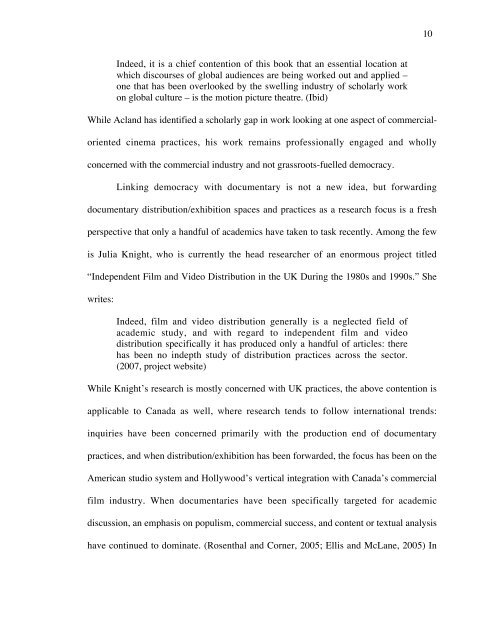The Spaces Between Grassroots Documentary ... - Ezra Winton
The Spaces Between Grassroots Documentary ... - Ezra Winton
The Spaces Between Grassroots Documentary ... - Ezra Winton
You also want an ePaper? Increase the reach of your titles
YUMPU automatically turns print PDFs into web optimized ePapers that Google loves.
Indeed, it is a chief contention of this book that an essential location at<br />
which discourses of global audiences are being worked out and applied –<br />
one that has been overlooked by the swelling industry of scholarly work<br />
on global culture – is the motion picture theatre. (Ibid)<br />
While Acland has identified a scholarly gap in work looking at one aspect of commercial-<br />
oriented cinema practices, his work remains professionally engaged and wholly<br />
concerned with the commercial industry and not grassroots-fuelled democracy.<br />
Linking democracy with documentary is not a new idea, but forwarding<br />
documentary distribution/exhibition spaces and practices as a research focus is a fresh<br />
perspective that only a handful of academics have taken to task recently. Among the few<br />
is Julia Knight, who is currently the head researcher of an enormous project titled<br />
“Independent Film and Video Distribution in the UK During the 1980s and 1990s.” She<br />
writes:<br />
Indeed, film and video distribution generally is a neglected field of<br />
academic study, and with regard to independent film and video<br />
distribution specifically it has produced only a handful of articles: there<br />
has been no indepth study of distribution practices across the sector.<br />
(2007, project website)<br />
While Knight’s research is mostly concerned with UK practices, the above contention is<br />
applicable to Canada as well, where research tends to follow international trends:<br />
inquiries have been concerned primarily with the production end of documentary<br />
practices, and when distribution/exhibition has been forwarded, the focus has been on the<br />
American studio system and Hollywood’s vertical integration with Canada’s commercial<br />
film industry. When documentaries have been specifically targeted for academic<br />
discussion, an emphasis on populism, commercial success, and content or textual analysis<br />
have continued to dominate. (Rosenthal and Corner, 2005; Ellis and McLane, 2005) In<br />
10


